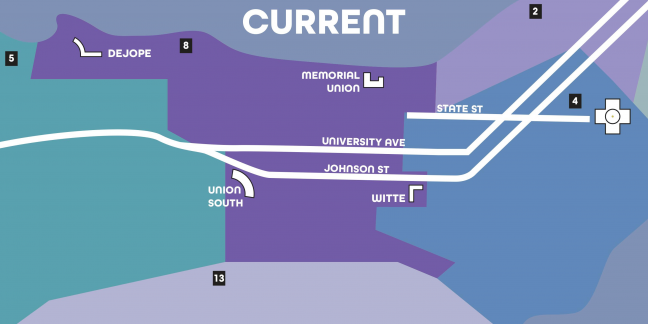Following the late release of the 2020 Census, Madison City Council members have been working on a redistricting plan to redraw the city’s aldermanic districts.
Some of maps proposed in the city redistricting process threatened to split up District 8, which contains University of Wisconsin residence halls and UW student apartments. The district has been represented by a student or a recent graduate for many years.
Though the city’s redistricting committee selected a map in the end that kept a majority of dorms and residence halls together, it serves as an important case study for how redistricting can dilute the voices of communities. While this seems like a very straightforward issue, it is actually extremely complicated.
What exactly is redistricting? Redistricting is the process of drawing electoral district boundaries. The process occurs every ten years along with the national census.
Redistricting is important because the district lines determine where voters’ ballots are cast, affecting which people they elect to represent them. It is also a process that is vulnerable to the corruption of gerrymandering, which is “the intentional manipulation of the redistricting process by people in political power to keep or change their political power,” according to the League of Women Voters.
Gerrymandering can manifest in a multitude of ways. For example, consolidating communities into one district would give the community only one representative in the legislature, and dividing the community across districts can cause that community to be in the minority and in result inadequate representation.
These practices are known as packing and cracking, respectively. Cracking and packing both refer to the “specific ways of drawing legislative boundaries with the outcomes of elections in mind.”
Gerrymandering is a very prevalent issue in Wisconsin, specifically. In “Gill v. Whitford”, the plaintiffs argued that the Republican majority in Wisconsin used this strategy in the “2011 redistricting process to maintain and bolster its majority in the state Assembly and Senate.”
In this context, it is important to evaluate the effects the proposed maps could have had on the student voice. One of the concerns with the proposed map was that UW students would be inadequately represented if they were split up into different districts. Before forming an opinion on the proposed maps, it’s necessary to examine the motivation behind splitting up students.
Data from the 2020 census shows that Madison has grown 16% in the past decade to an official population of 269,942. Districts are supposed to be as equal as possible, so if the twenty council seats are divided equally, then each district should have about 13,497 residents.
The redistricting committee hopes to be within 5% of that target number, making each district fall between 12,822 to 14,172 residents.
District 8, where a large student population resides, has overgrown its allocated size. There are currently 15,445 residents in District 8. So while it may seem ideal to maintain the current boundaries, in order to keep representation as equal as possible District 8 must shrink.
According to city planner Ben Zellers, it was possible to draw a boundary that includes all undergraduate residence halls, but it could exclude other off-campus areas where students also live. The redistricting process is a push and pull. Thus, there isn’t a plausible situation in which everyone gets what they want.
The Redistricting Committee has now recommended Alder District Concept 7a, which includes a lot of the residence halls, and keeps together some of the off campus residences. Regardless, students would be extremely represented in District 8.
It seems like the committee is trying to split up the UW voting body simply as an act of practicality. There isn’t malice in the act of dividing the students into separate districts. By the looks of it, the committee is trying to work with the circumstances handed to them, the circumstances being: the overpopulation of District 8.
There are many examples of gerrymandering in Wisconsin, specifically racial gerrymandering which marginalizes the voices of minority groups already fighting to be heard and represented. Because of Wisconsin’s history with gerrymandering, it’s understandable that students would worry it is occurring now in the redistricting process.
Though the recommended map includes most of the student population, it’s always important to ask questions, like why groups would try to split up the UW voting body in the first place.
Matters of representation and potential corruption should always be taken seriously. Student’s opinions in the redistricting process and the asking of these difficult questions show how bright students at UW are.
Jessica Lewin (jrlewin2@wisc.edu) is a sophomore studying journalism.


